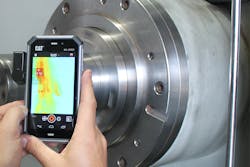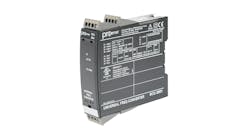How modern predictive maintenance systems can benefit the food processing industry
Even though the entire manufacturing world is talking about the Industrial Internet of Things (IIoT), digitalization, process automation and predictive maintenance, there are still a couple of industrial sectors that tend to be more conservative in these areas. Compared to the automotive and aerospace industries, the food and beverage manufacturing sector has always been a late adopter of digital trends. As many other industries, food and beverage faces challenges in recruiting and retaining qualified individuals. Also, compared to other industries, food processing has to overcome much more specific manufacturing and maintenance obstacles related to hygienic standards and safety. This makes it difficult for plants’ managers to adopt new solutions especially when established practices as preventive maintenance routines work good enough.
Predictive maintenance is certainly possible, as practices in other industries have already shown, but the biggest obstacle remains cost. However, that’s beginning to change. The prices of infrared thermometers, ultrasonic probes, monitors and other condition-monitoring tools are constantly declining. Intuitive, user-friendly and next-generation computerized maintenance management systems (CMMS) offer end users a flawless connection to all the company’s systems to produce powerful data analytics at a reasonable cost. Last but not least, the benefits of industry 4.0 maintenance has undoubted advantages and despite the limited budget, professionals try to find a way to integrate it. Their biggest motivation is the evidence that smart connected systems are and will remain in the future the most important competitive advantage.
Why food and beverage manufacturers face more challenges than those in general industry
Hygiene, food and beverage safety and the adherence to strict regulations require the continuous upgrade of sanitation equipment. The ongoing costs for microbial testing, pest control and consultants are inevitable as well, since all products are intended for human consumption and should be certified. Also, the need for heightened cleanliness creates a wet environment, which can easily damage important equipment. In addition, all switches and electrical components must be reliably protected from moisture. This process requires the purchase of extra machinery and its specific maintenance.
Second, the machines deployed in the food processing industry are highly complex and challenging to maintain due to the connected system of conveyors, belts and fasteners.
Tools needed to implement predictive maintenance at a food processing plant
Condition-monitoring tools are at the heart of a predictive maintenance routine. By delivering regular data on an asset’s health and detecting deviations from the norm, sensors help maintenance specialists to predict when equipment failure might occur. Some of the common condition-monitoring techniques include vibration analysis, oil analysis and thermal imaging.
If predictive maintenance has been successfully established, maintenance is only performed on machines when it is required, which means at the lowest possible frequency. This results in minimized production hours lost to maintenance and significant cost savings.
Next-generation CMMS for predictive maintenance routines
Sensor data are uploaded to the CMMS and analyzed in the context of other important equipment data as intervention history and spare parts. Only when compared to other metrics, condition-monitoring data deliver valuable insights into assets’ health. Some Industry 4.0-inspired CMMSfeature analytics tools that issue predictive algorithms.
A next-generation CMMS also offers the possibility to study inventory of all the equipment currently used, assess the risk each piece of equipment poses and prioritize the most important assets. A CMMS will be one of the most important tools when establishing and following preventive maintenance routines, which — for the moment — remain the most crucial ones for the sector. Collecting data on a machine’s daily behavior and combining it with the manufacturer’s guidelines will help create a reliable and successful maintenance strategy. Now imagine all this information is accessible to all authorized staff members anytime and anywhere from any smart device. If suddenly someone needs to take over the job, the only thing he or she has to do is to simply look at the detailed maintenance records. Furthermore, traceability is always a priority in the food industry in a case of safety inspections.
CMMS benefits at a glance:
- Study inventory of equipment
- Create maintenance schedule
- Record, track and analyze every maintenance intervention
- Support the team in safety management
- View, organize, schedule and execute equipment maintenance throughout the entire food processing chain
- Reduce breakdowns, minimize shutdowns and increase productivity
New CMMS technology available can also provide a platform that connects suppliers, service providers and maintenance professionals from all over the world. Programs, such as Mobility Work, offers a maintenance management platform where suppliers, managers and industrial professionals can create profiles, upload products, look for services and share experience.
How can predictive maintenance help the food and beverage sector overcome its equipment maintenance challenges?
The biggest contribution of predictive maintenance to food and beverage manufacturing can be summarized in two phrases: operational efficiency and functional performance. The first one is about keeping assets well maintained and operational and the second one encompasses the ability of the method to sustain a consistent product quality.
Although the initial investment is quite high, a long-term predictive maintenance is a cost-efficient strategy, contributing to the significant decrease of maintenance and spare parts expenses and to the increase of active production hours.
Equipment that is situated in a critical environment with the tendency to keep moisture can be prioritized and more frequently observed. Machines will be maintained only when necessary, which will save time and leave the technicians longer splits to clean complex assets.
Predictive maintenance, combined with a next-generation CMMS can help food and beverage professionals to comply with the most stringent health and safety regulations by ensuring that equipment uptime is maximized and response time to breakdowns and failures is improved. A solid and reliable maintenance software inspired by the latest digital trends guarantees responsive and efficient equipment performance and is of critical importance for food processing plant operations.
New solutions allow easy connection to all of the company’s smart systems and encompass functionalities for managing work orders, assets, spare parts inventory, maintenance schedules and predictive analytics.
In conclusion, predictive maintenance helps the food and beverage sector to overcome its equipment challenges by improving regulatory compliance, promoting lean methods and, therefore, streamlining the process and maximizing technicians’ schedules.
Modern maintenance comprises simple but smart CMMS ensuring facilities and procedures are in line with industry standards and regulations, condition-monitoring tools and connected systems. A next-gen maintenance strategy can immediately ease problems related to inventory control, inspections and asset management at the food processing plant. Industry 4.0-induced strategies are the perfect fit to the highly regulated and controlled maintenance within the food and beverage manufacturing sector.
Ralitsa Peycheva is a technical content manager at Mobility Work interested in latest machinery tools, technical maintenance, CMMS and Big Data; curious about new manufacturing methods; discovering, observing and admiring high-quality engineering. Follow Ralitsa on Google+ and Twitter.



